Why Chile is a Top Destination for Global Professionals
In recent years, Chile has emerged as one of Latin America’s most attractive countries for skilled professionals, remote workers, and international investors.
With a stable economy, modern infrastructure, and strong demand for foreign expertise in sectors like mining, engineering, IT, and education — Chile work visa 2025 updates are designed to make hiring international talent smoother yet more regulated.
However, before your work visa is approved, one critical step stands out — the contract validation process.
In this detailed 2025 guide, you’ll learn:
- What contract validation means in Chile
- Step-by-step application instructions
- Employer responsibilities
- Required documents
- Common mistakes to avoid
- And how the new 2025 rules affect both employees and employers
Let’s break it down clearly
What is the Work Contract Validation Process in Chile?
In Chile, “Contrato de Trabajo Visado” (Visa-approved Work Contract) refers to an employment contract that has been validated and notarized according to Chilean labor and immigration law.
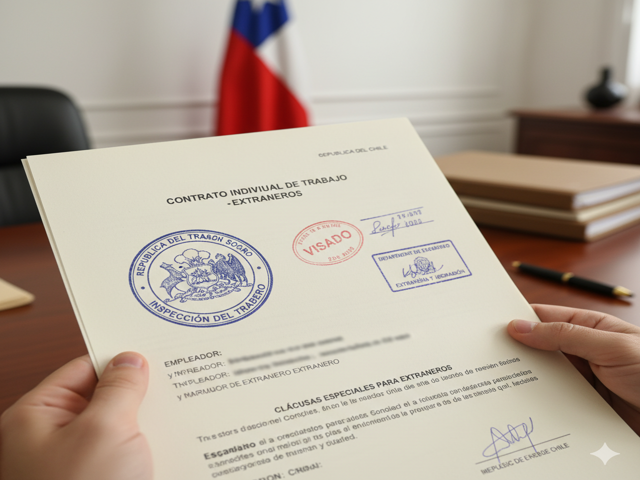
It ensures that the job offer to a foreign worker is:
- Genuine (from a legally registered Chilean employer)
- Compliant with local labor standards (minimum wage, benefits, insurance)
- Aligned with the visa category being applied for
In short — it’s a legal verification that your work relationship meets Chilean government standards before your visa is issued.
Chile Work Visa 2025 Updates: What Changed in Chile’s Contract Validation System?
In 2025, Chile’s Ministry of Foreign Affairs and the Servicio Nacional de Migraciones (SERMIG) introduced new digital reforms to the contract validation process.
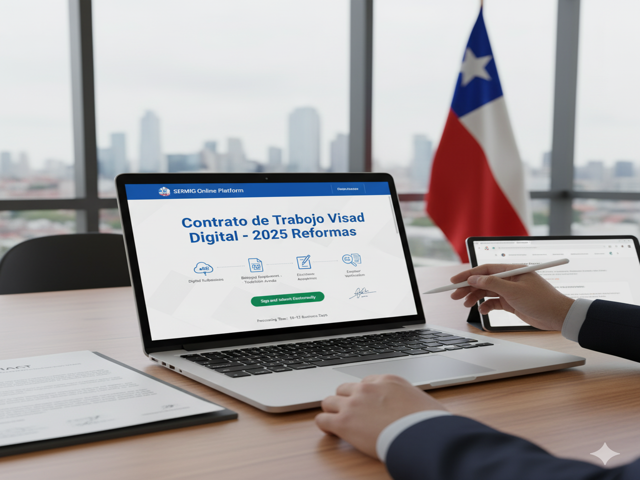
Here’s what’s new:
- Digital Submissions:
Employers and applicants must now submit contracts through the SERMIG Online Platform rather than physically at consulates. - Bilingual Requirement:
All foreign-signed contracts must include a Spanish translation validated by a certified translator. - Electronic Signature Acceptance:
As of 2025, digital signatures from both parties are accepted if registered with a Chilean-certified provider. - Employer Verification:
The employer must verify their RUT (Tax ID) and company registration via the Registro de Empresas database. - Faster Processing:
The average validation time has been reduced from 30 days to 10–15 business days.
These updates aim to make Chile’s visa processing more efficient and secure for both local employers and international professionals.
Step-by-Step: Chile Work Visa 2025 Contract Validation Process
Here’s the official 2025 process for validating your employment contract before your Chile work visa 2025 is approved.
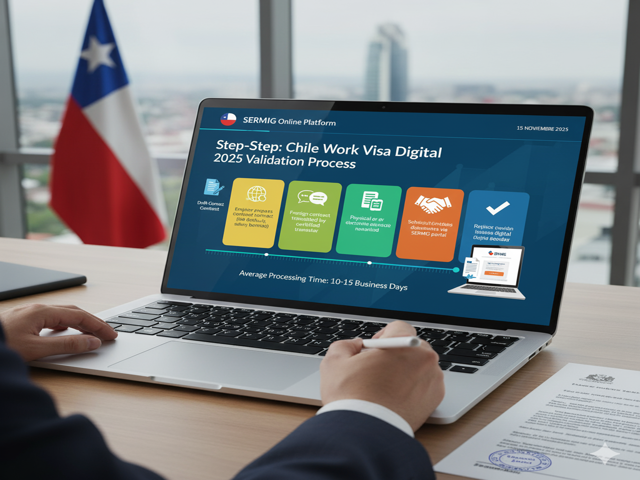
Step 1: Employer Drafts the Work Contract
The employer prepares a standard employment contract following Chilean labor law guidelines.
It must specify:
- Job title and duties
- Duration (fixed or indefinite)
- Monthly salary (in CLP or USD equivalent)
- Benefits and insurance (AFP, health coverage)
- Termination clauses
- Work location and hours
Tip: Always ensure the salary clause meets Chile’s minimum legal threshold (updated yearly by the Ministry of Labor).
Step 2: Legal Translation (if required)
If the contract is in another language, it must be translated into Spanish and notarized by a certified translator recognized by Chile’s Ministry of Justice.
Step 3: Notarization of Signatures
Both the employee and employer must sign the contract.
The signatures should be:
- Physically notarized in Chile, or
- Electronically signed using an approved digital certificate
Foreign employees abroad can notarize their signatures through the nearest Chilean consulate.
Step 4: Submit via the SERMIG Online Portal
Employers upload the following documents:
- Signed employment contract (PDF)
- Employer RUT certificate
- Employee passport copy
- Translation & notarization proof (if applicable)
Website: https://tramites.extranjeria.gob.cl
Step 5: Review & Validation by SERMIG
SERMIG reviews the contract to ensure compliance with Chilean law.
They verify:
- Salary and benefits alignment
- Employer legitimacy
- Translation accuracy
- Proper signatures
If approved, you’ll receive a digital validation certificate — required to proceed with your work visa application.
Applying for the Chile Work Visa 2025 After Contract Validation
Once your contract is validated, you can begin your work visa application through Chile’s immigration portal.
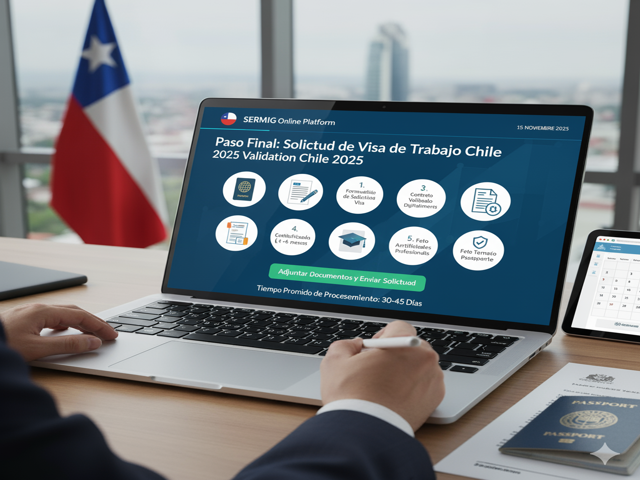
Required Documents:
- Valid passport (6+ months)
- Visa application form
- Validated employment contract
- Proof of qualifications or degree
- Passport-sized photo
- Police clearance certificate
- Medical fitness report
Average processing time: 30–45 days
Note: Your visa start date begins only after validation approval, so start early!
Employer Responsibilities Under the Chile Work Visa 2025 Rules
Employers hiring foreign workers in Chile must:
- Register on the SERMIG employer portal
- Maintain proof of tax compliance (RUT active)
- Contribute to employee’s AFP pension & health funds
- Notify SERMIG if the contract ends early
Failure to follow these rules may result in employer suspension from hiring foreign nationals.
Common Mistakes to Avoid
- Submitting unsigned contracts (instant rejection)
- Missing salary clause in CLP
- Forgetting to translate documents into Spanish
- Using an unregistered employer or agency
- Applying before contract validation approval
Pro tip 💡: Always double-check the validation confirmation email before proceeding with visa filing.
Benefits of the Chile Work Visa 2025 Digital Validation System
- ✅ Faster processing time
- ✅ Reduced paperwork
- ✅ Improved fraud prevention
- ✅ Legal transparency for both parties
- ✅ Easier access for remote foreign applicants
Chile’s move to digitalize the process reflects its commitment to modernization and global mobility.
Career Sectors with High Demand for Foreign Workers (2025)
If you’re planning to work in Chile in 2025, these sectors are currently most open to international hires:
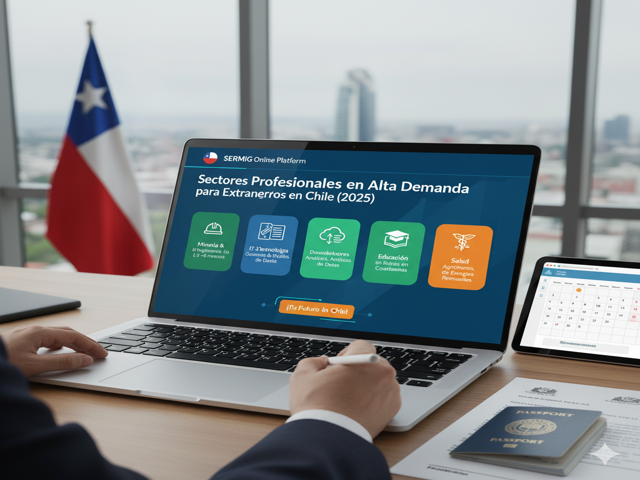
| Sector | In-demand Roles |
|---|---|
| Mining & Engineering | Geologists, Civil Engineers, Project Managers |
| IT & Technology | Software Developers, Data Analysts, Cloud Engineers |
| Education | ESL Teachers, Academic Coordinators |
| Healthcare | Nurses, Physiotherapists, Lab Technicians |
| Agriculture & Energy | Agronomists, Renewable Energy Technicians |
Read Also: Argentina Citizenship 2026: Exciting New Residence Rules
FAQs: Chile Work Visa 2025 & Contract Validation
Q1. How long does the Chile Work Visa 2025 contract validation process take?
Usually 10–15 business days, depending on document accuracy and translation requirements.
Q2. Can I apply for the visa without a validated contract?
No. The validated work contract is mandatory before submitting your visa application.
Q3. Does Chile accept remote work contracts for visas?
Only under specific temporary or digital nomad categories, not standard employment visas.
Q4. Can I change employers after getting a visa?
Yes, but you must repeat the validation process for the new employer.
Q5. What happens if my contract is rejected?
You can resubmit after correcting errors or updating documentation.
Expert Tips for a Smooth Application
- Use the official SERMIG website only — avoid third-party agents.
- Translate all documents professionally, not via auto tools.
- Always maintain a soft copy backup of your contract validation certificate.
- Start at least 2 months before your travel date to avoid delays.
Agent Advise: Your Pathway to Working Legally in Chile Work Visa 2025
The Chile Work Visa 2025 contract validation process is your first legal checkpoint before employment begins.
Thanks to the 2025 reforms, it’s now faster, safer, and fully digital — empowering foreign professionals to build their careers in one of Latin America’s most forward-thinking nations.
If you follow the steps carefully and prepare your documents correctly, your Chilean work visa approval will be smooth and hassle-free.



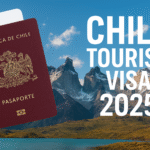
Pingback: Chile Tourist Visa 2025: Essential & Easy Entry Guide
Pingback: Chile Investor Visa 2025: Powerful Business Setup Guide
Pingback: Chile Temporary Residence 2026: Smart & Complete Guide